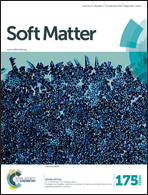Effects of resveratrol on the structure and fluidity of lipid bilayers: a membrane biophysical study†‡
Abstract
Resveratrol is a natural active compound which has been attracting increasing interest due to its several pharmacological effects in cancer prevention, cardiovascular protection and treatment of neurodegenerative disorders and diabetes. The current work investigates how resveratrol affects membrane order and structure, gathering information determined by X-ray scattering analysis, derivative spectrophotometry, fluorescence quenching and fluorescence anisotropy studies. The results indicate that resveratrol is able to be incorporated into DMPC liposome model systems, either fluidizing or stiffening the bilayer, which largely depends on the membrane fluidity state. These findings suggest that the effects of resveratrol resemble cholesterol action on biological membranes, thereby contributing to the regulation of cell membrane structure and fluidity, which may influence the activity of transmembrane proteins and hence control the cell signaling pathways. The regulation of a number of cellular functions, thus may contribute to the pharmacological and therapeutic activities of this compound, explaining its pleiotropic action.


 Please wait while we load your content...
Please wait while we load your content...